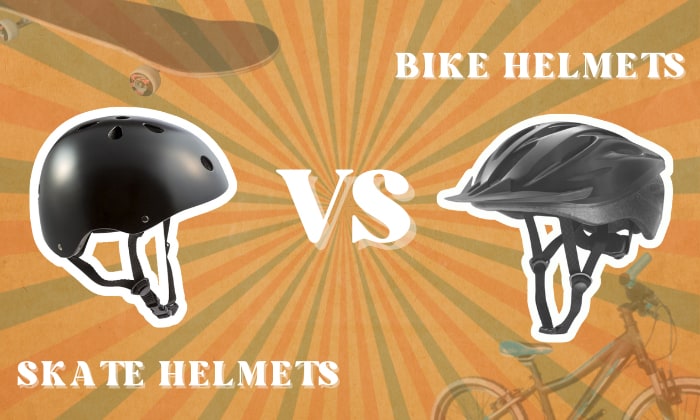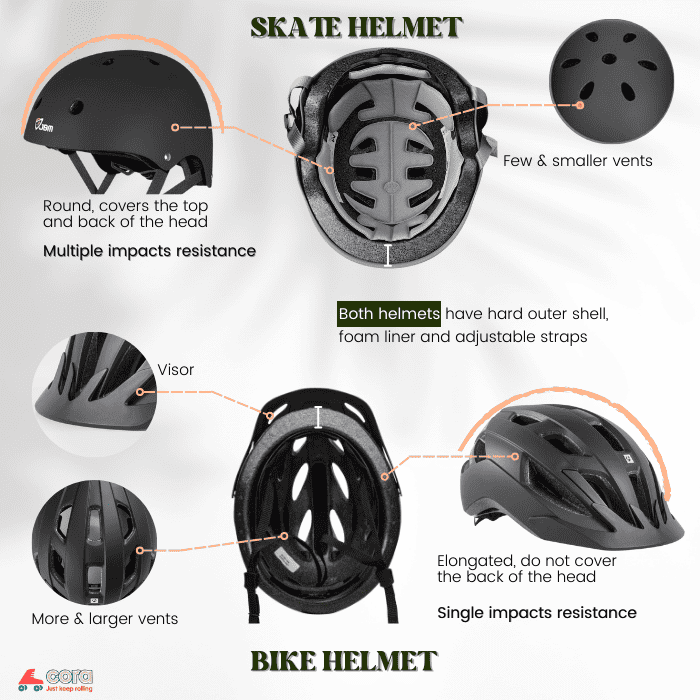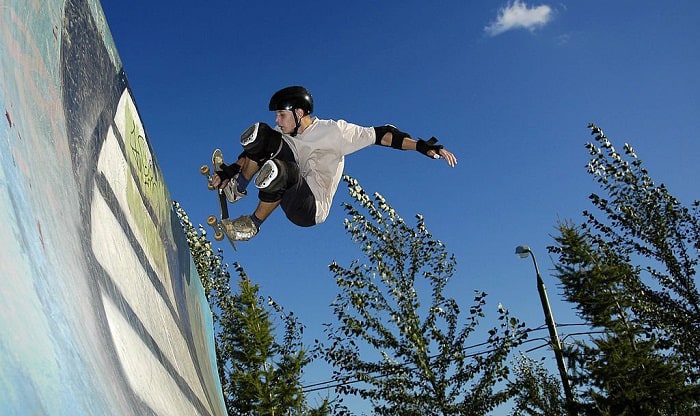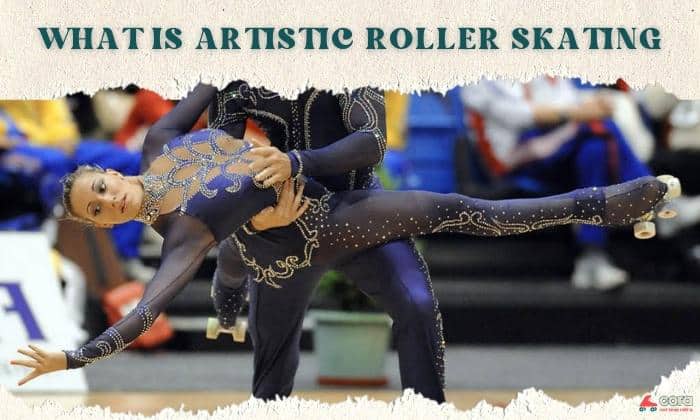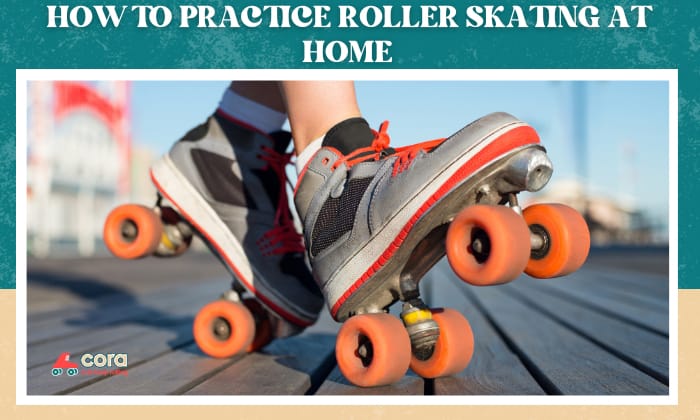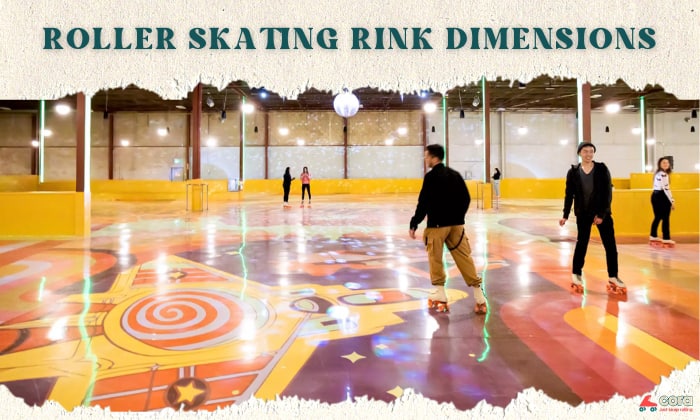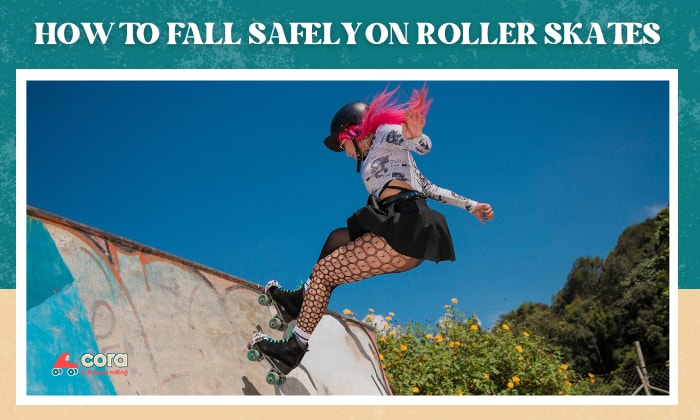If you already own a bike helmet and are picking up skating, or vice versa, you might wonder if it is necessary to purchase another sport-specific helmet. To help you decide, we have put together this comprehensive comparison guide on skate helmets vs. bike helmets.
To get a brief idea of their distinctions, look through this summarized comparison chart.
| Helmets for Skating | Helmets for Biking/Cycling | |
| Coverage | Covers the top and back of the head | Most do not cover the back of the head, except helmets for mountain cycling. |
| Safety Certifications | ASTM F1492, CPSC | CPSC, EN1078 |
| Impact Resistance | Multiple impacts | Single impacts |
| Vents | Usually only a few small ones | Usually many large ones |
| Visors | Usually not included | Usually included |
| Style | Youthful, trendy | Casual, simple |
As you can see, there are a few important differences. We will look through them in detail later.
Page Contents
Head-to-Head Comparison – Differences
1. Coverage
The first difference between skate and bike helmets is the shape. Most biking helmets are designed without coverage for the head’s back. This is not because manufacturers are stringy on material but because riders don’t normally fall backwards in the event of a crash.
However, mountain bikes do provide coverage for the back of the head. So, if you wear a BMX helmet (a mountain bike helmet) on the road and somehow fall backwards, your head’s back will be shielded.
On the other hand, a proper helmet for skating provides full head coverage. You can put two and two together: these helmets cover the back of the head because skaters are more likely to fall backwards.
2. Safety Certifications
This difference in coverage also translates to different safety certifications. While both bike and skate helmets meet baseline safety standards, skate helmets prioritize high-impact resistance and multi-impact protection – crucial for falls from any angle.
This is reflected in certifications like ASTM F1492 and CPSC, which are more stringent in these areas compared to the CPSC or EN1078 standards for bike helmets, which focus more on single impacts, ventilation, and aerodynamics for forward-facing crashes.
So, while both helmets offer protection, skateboarders need a helmet designed for their riskier falls, reflected in the specific safety standards they meet.
3. Impact Resistance
Since skating helmets and bicycle helmets are worn as safety equipment, it is essential to take note of their abilities to withstand extreme force and prevent a more severe head injury.
A certified helmet for biking meets the Consumer Product Safety Commission (CPSC), which entails that bike helmet shells can sustain a single impact, such as a collision with a vehicle or a fall at speed. A collision as such, compresses the internal foam and will require you to get new headgear.
- Note: Because of this characteristic, bicycle headwear is sometimes also called single-hit helmets.
As for skating, helmet safety standards mandate a thicker outer shell and softer foam that ensures the same headgear can withstand several low impacts. Unlike bike headwear, you can get more service life from skating helmets.
4. Vents
Many people dismiss vents as a fancy add-on feature. But in reality, it places a crucial role in bike riding and skating. Vents make it possible for air to flow in and out of the helmet. Thus, your head can stay cool and sweat-free.
Bike helmets offer large vents in the front and the back. Meanwhile, most skateboard helmets only have a few small air ventilation holes. This is because keeping the head cool is not as critical for skaters, as they do not generate as much heat or spend long hours under the sun as bikers do.
5. Visors
Skateboard helmets typically do not have visors, while some bicycle helmets do.
More specifically, mountain bike helmets include visors, whereas road bike ones don’t. This is because road cyclists tend to wear sunglasses as they travel. Plus, riding bikes requires cyclists to keep their heads low. Equipped visors can interfere with their line of sight.
On the other hand, sunglasses usually aren’t enough to protect mountain bikers’ eyes from debris; hence riders tend to require either visors or goggles. That said, visors don’t hold in heat as much as goggles, so they are a more popular choice for riders in hot regions.
6. Style
Though not as emphasized as safety standards, style is worth considering when choosing a helmet to wear. Today, both bike helmets and skate helmets come in many styles. They have various designs so users can wear helmets that fit their preferences.
In general, skate-style helmets tend to be more youthful, filled with swag, and have street vibes, whereas bike helmets are more casual and simple with solid, plain colors. For kid headwear, there can be prints of characters, like a cat or a pirate.
7. Pros and Cons
Now, let us go over the pros and cons of bike vs skate helmets as a recap.
| Pros | Cons | |
| Helmets for Skating | – Covers the back of the head – Withstand multiple impacts – Trendy, young style |
– Lack vents – Lack visors |
| Helmets for Biking/Cycling | – Often equipped with vents – Often comes with visors – Meet the CPSC standards |
– Most do not cover the entire head – Casual, simple style |
Why is It Important to Choose the Correct Helmet?
You have probably read this somewhere before a helmet saves lives. Wearing one can reduce your risk of brain injury and skull fracture in an accident. Choosing suitable headwear ensures that you can keep yourself safe. This is the same for both bike helmets vs. skate helmets.
And, yes! It is possible to rely on bike helmet shells while skating or vice versa as long as they are dual-certified. Specifically, it is necessary to meet the CPSC 1203 and ASTM F1492 standards. If you are contemplating a multi-sport helmet, look for the standard stickers. Also, check whether the headgear can cover the back of your head.
When Should You Replace Your Helmet?
For both bike helmets and skateboard helmets, it is critical to get a new helmet after sustaining a big blow. You must also get a new one if you notice signs of damage. This applies to both skate and bike helmet shells. Several common signs to look for:
- Cracks
- Bumps
- Scrapings
- Deflated Foam Paddings
Also, check the straps, buckles, and any adjustment systems. They should all work smoothly. If not, you should certainly consider switching to a new one.
Conclusion
Congrats! Now, you know the essentials to skate helmets vs. bike helmets. Hopefully, you can apply what you have read to browse modern headgear and pick the right one for yourself.
Share your selection experience with us in the comments down below. We (and probably other readers) would love to hear from you and see pictures of your bike and skate helmets!
Always remember: helmets save lives – always wear one while on the road or skating.

Harrison is a skating enthusiast who picked up the sport during her student exchange years in Canada. She has been a skating coach for children and teens for 3 years and now holds classes as a freelancer. Harrison entwines her experience leading skating classes in the content published on Cora to help readers fall in love with skating, just like she did.


